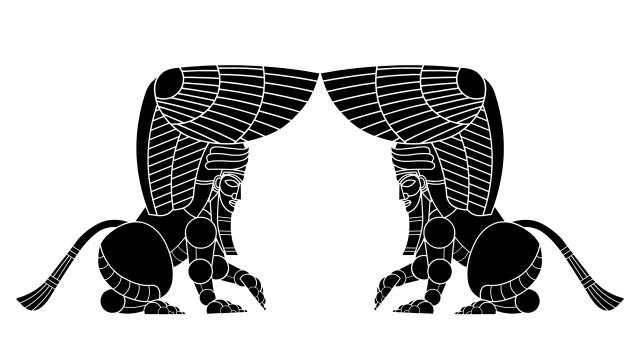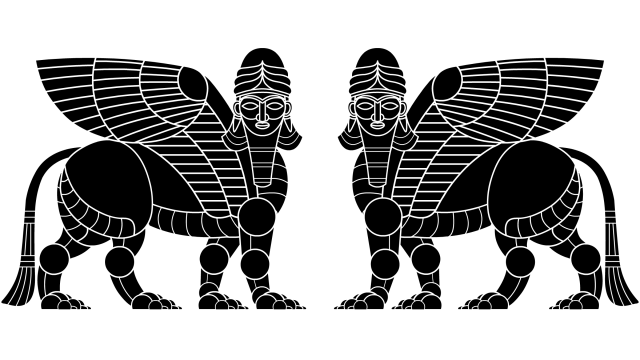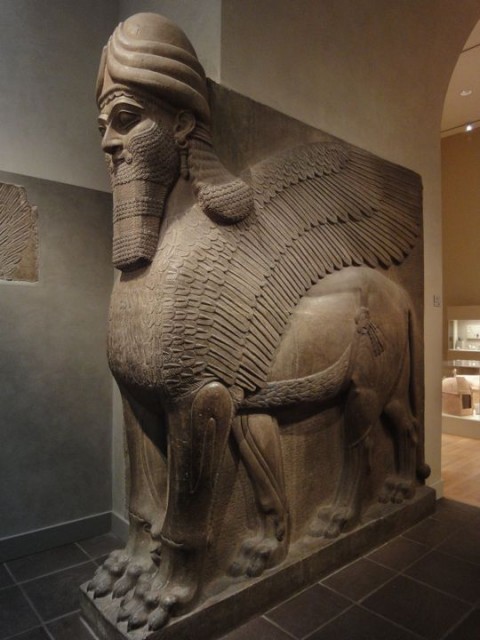I know some people will call me anti-semitic (that’s why I have this), but there’s just not that much Jewish art out there. Sure, there’s great art by Jewish artists – I’m no slouch myself. But there’s not much art illustrating Jewish scripture, the books of Moses, the Torah, by Jews. Most illustrations of Exodus are by Christians and this guy; illustrations with historical weight are all almost all found in churches and Bibles, the exception being some illuminated Haggadot from the Middle Ages. Yes, I know there’s Jewish art outside of illustrations: Torah cases, Torah ornaments, Kiddish cups, book covers, candlesticks, textiles. And there’s lots of abstract art: decorated Hebrew letters and symbols. But I’m trying to find a way to illustrate Exodus in animation (see Seder-Masochism), and there’s just not much visual art tradition to build on.
What did ancient Hebrew art look like? Egyptian aesthetics influenced Assyrian art, and vice-versa, and Canaan lay between the two. Surely Egyptian and Assyrian visual art must have influenced Hebrews, just as their mythologies influenced the concept of Yahweh (the “no other gods before me” referred to neighboring deities, at least that what scholars, friends and the interwebs tell me). I can hardly find any pictures of the famous Megiddo Ivories online; I imagine they’d be a great source for me, but what can I do?
Turn to Assyrian art, that’s what.
This shedu is a gatekeeper, part of a pair. I love these things. Why aren’t there more mythical composite animals in Abrahamic religions? The Book of Kells has awesome fanciful creatures, but it’s not Jewish, and the creatures it depicts aren’t overtly mentioned in the text – although the text has been interpreted any and every way, so fanciful creatures might honestly capture its spirit as revealed to the artists. As an artist myself, I know that some things just look cool. Really cool. So cool you don’t care whether they accurately illustrate anything. That’s how I feel about shedus.
Fortunately, shedus may have influenced the Mosaic concept of cherubim. And right there in Exodus, after commanding the Hebrews to not make any graven images, Yahweh commands the Hebrews to make him some graven images of 2 cherubim to put on top of the Ark of the Covenant!

I’m so fascinated by shedus I made my own “shedu puppets” in Flash, with the possibility of animating them. Whether or not I ever make Seder-Masochism, or these guys make it in, I’m happy to be inspired by such great, ancient design.




I think you are not likely to find much Jewish representational art because a prohibition against such is built into the religion — the rule against making graven images that could lead to worship of them, that is, idolatry. Maybe you’ve already mentioned this.
These look very animatable!
A sheyd (שד, plural ×©×“×™× sheidim) in Jewish mythology is an animistic spirit (sometimes translated as demon or satyr), and is often portrayed as chimerical. I’d be surprised if the shedu and the shed didn’t share a common stem.
Re: graven images and the qeruvim, they’re not only what’s on the ark cover. It’s also what’s decorating the parochet — the partition and the walls inside the qodesh haqedashim — the Holy of Holies (besides images of flowers, vines and other vegetation) as Raphael Patai writes in The Hebrew Goddess. They’re super important divine images and I think Patai does a great job at unpacking their meaning. When I was taught the ten commandments as part of the book of Exodus in 6th grade, the “no graven images” applied to representations of G!d only, not to illustrating anything else.
Re: haggadot. For modern masterworks, make sure to see the Haggadah by Arthur Szyk and the one by Rabbi Yossi Rosenstein. You mention the illuminated medieval haggadot and indeed, that’s where you’ll find illustrations related to Genesis and Exodus — make sure to see the Bird’s Head haggadah, the Sarajevo haggadah, etc. And then there are the illustrations which you can sometimes find in medieval siddurim before a certain period. I wouldn’t give the fanciful chimeras that often decorate torah scroll covers and torah ark covers short shrift even if you are representing the Exodus. I’m not convinced that Jewish visual art is as restricted as you think in illustrating biblical stories or legends. Visitors to medieval synagogues reported illustrated frescoes, so it isn’t necessary to go back to the Dura Europos synagogue. The shame is what survived the last few hundred years of oppression in Europe. The anthropological question I have is, if the visual arts was popular up until the early modern period, what changed.
Also, those shedu are amazing! Can’t wait to see them animated. So long as you’re animating creatures out of Jewish biblical/rabbinic mythology and folklore, can I recommend images of the Bar Yokhani (a sort of fabulously large bird the yolk of whose egg when broken could flood 60 cities), the Behemot/Shor ha-bor (the Ox of the Pit), the Re’em (other fabulously large land animals), the Leviatan (coiled and uncoiled cosmic serpents), and the fabulous images describing the numinous divine bureaucracy in Yechezkel (Exekiel). If you don’t read about them in Exodus, it’s not really a problem — through the agency of midrashic lore, nothing is really disconnected in the Hebrew Bible and Torah she’baal peh (oral Torah).
not related to the exodus, but rather to the babylonian exile, but…
if you’re interested in biblical descriptions of cherubim, definitely check out ezekiel 10. in this chapter, god’s glory (“kabod”) leaves the temple and ascends. i think you will find it very descriptive and highly animatable.
There is tons of Jewish contemporary art that deals with specifically Jewish sources. Check out jewishartsalon.com specificaly Archie Rand and Richard Mcbee, amongst many others.
I’m looking for ancient/historical/traditional art, not contemporary.
I have a real soft spot for those illuminated texts — I’d mostly seen Bibles before, thanks for the Haggadot search.
Maybe it’s because I used to doodle so much in my notes. 🙂
Please note that this shedu, at least, is equipped with five legs. Maybe six.
Oh wow, good catch Momz!
@ Momz
In Ancient Assyrian art and some other middle eastern art from that period, it was common to make statues with both a frontal (en face) and side (en profile) view. It was meant to be seen from two perspective points: in front of the animal, where you see the two legs en face, and from the side, where you see all four of it legs en profile. It wasn’t meant to be thought of as a 3dimensional whole. Think of it more as a comic book, in which you first see the creature from the front, and in the second panel you see the creature from the side. It is wholly another way of viewing, which is very different from our modern way of viewing statues. So it should still be seen as a creature with four legs, seen from two different perspectives.
Sorry for the lecture and my bad english (not a native english speaker)
Eh, the commandment refers to graven images of idols who are worshipped as gods, not rly depictions itself. Many protties overinterpretate this.
There was even – Only known depiction of Jehovah himself, on a Persian coin – https://upload.wikimedia.org/wikipedia/commons/8/84/Zeus_Yahweh.jpg (disregard the filename)
Tendency towards iconoclasm existed, but example of Dura-Europos shows us it was not always the thing. Even descriptions of the Temple of Solomon itself in the Bible.
Now the Cherubim, they had beastly and more humane form, just like Seraphim and Thrones/Ophanim. On all reconstructions of arks you see the latter, perhaps we’ll see the original one supposedly in Ethiopia one time?
For that depiction of Cherubim you see on mosaic with Heraclius there was even some Greek name, something-morph, but I can’t recall it.
On a side note Satan and Raziel were held to be of that angelic rank, but the latter also placed as one of the 7 angels of Presence by Enochian (Book, not the other meaning) account.
No, shedus/lamassus does not have 5 legs. They have 4. But on the limestone work in Sargon II palace, they are depicted with 4 legs on side-view and 2 legs in front view. It is not 5 legs, its just one extra leg for frontal view. But they are always depicted with 4 legs.
Discover the ancient Egyptian four-lobe pinion-pulley.
Was Carpenter Inty Shedu, with his powerful second name, overseeing the manufacture of pulley lobes formed of short planks of imported Lebanese Cedar ! ?
https://www.haitheory.com/Inty_Shedu.html